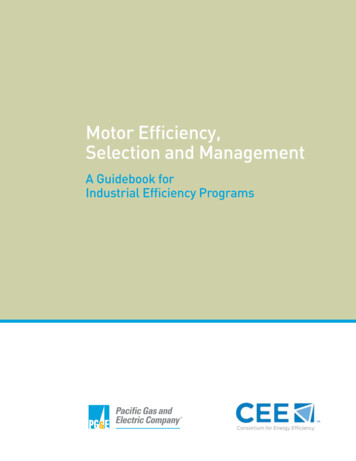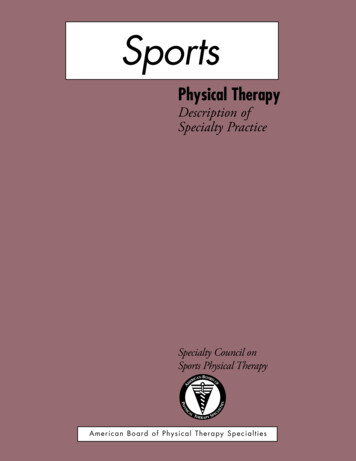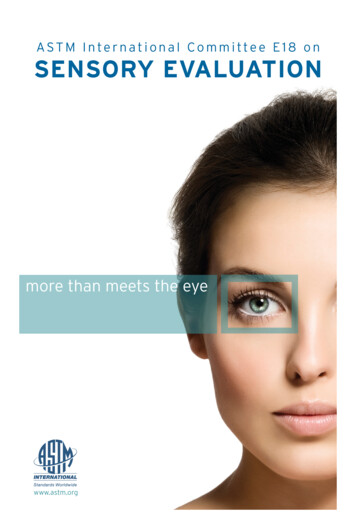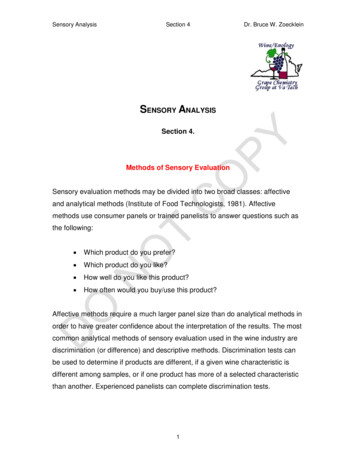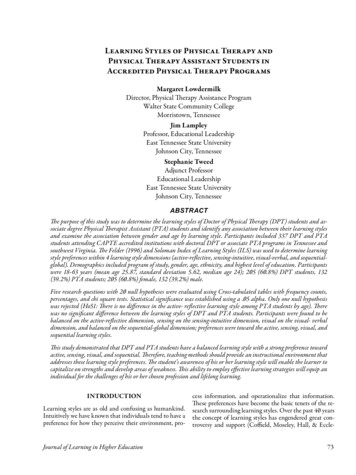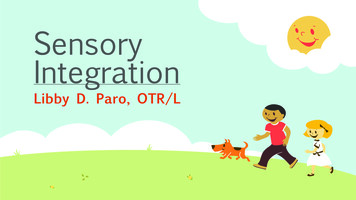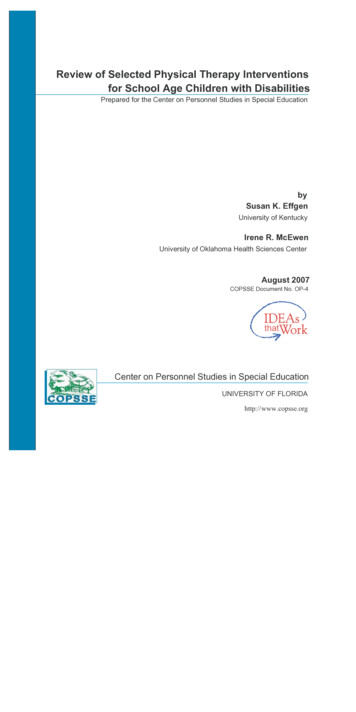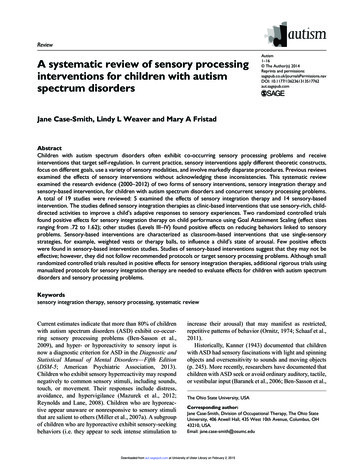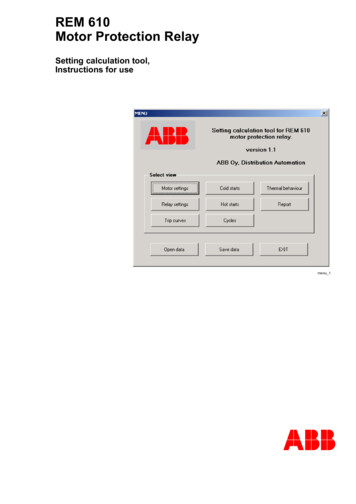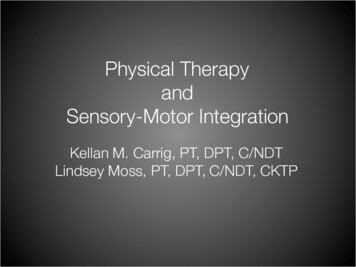
Transcription
Physical TherapyandSensory-Motor IntegrationKellan M. Carrig, PT, DPT, C/NDTLindsey Moss, PT, DPT, C/NDT, CKTP
Overview Perkins School for the BlindSensory processingSensory processing disorderSensory regulation and motor learningPhysical Therapy: Sensory-motor strategiesand interventions
“The Perkins mission is to provide education and servicesthat build productive, meaningful lives for children andadults around the world who are blind, deafblind or visuallyimpaired, including those with additional disabilities.”“ALL we see is possibility”www.Perkins.org
Perkins School Programming Perkins School (Day and Residential)– Early Learning Center (ELC) [ages 3-6]– Lower School [ages 6-15]– Secondary [ages 15-22]– Deafblind [ages 3-22]– Outreach, Early Intervention, Itinerate Perkins International Perkins Solutions Perkins eLearning Perkins Library
Perkins School Services Classroom Teacher Teacher of the VisuallyImpaired (TVI) Physical EducationTeacher Physical Therapy Occupational Therapy Speech Therapy Orientation & Mobility(O&M) Music Therapy Art Social Work Psychology Nursing Residential Staff
Common Diagnoses at Perkins Visual Impairments– Cataracts– Cortical Visual Impairment(CVI)– Glaucoma– Low Vision– Optic Nerve Hypoplasia– Retinopathy of Prematurity– Septo-Optic Dysplasia SENSORY PROCESSINGDISORDER Medical Diagnoses– Cerebral Palsy– CHARGE Syndrome– Developmental Delays– Downs Syndrome– Hydrocephalus– PDD-NOS, Autism– Prematurity– Seizure Disorder– Traumatic Brain Injury (TBI)– Other (Genetic, Acquired)
How Do We Process SensoryInformation? Take an object nearby you Describe the object in your head What senses did you use to describe it?– Sight, Touch, Taste, Smell, Hearing– Proprioceptive, Vestibular All your senses are important in your ability tolearn about and interact with your environment
Self Regulation & Routines What are your daily routines? Why do you need these routines? How would you feel if your routine was changed? We ALL have our own sensory diets– Sensory input can be alerting or calming– Daily activities provide us with input to keep usregulated to be able to become alert, relax, and focuson daily tasks
Insert too high pictures
Insert high engine pictures
Visual Processing GameThe next slide will havedirections for you to followPay Attention!
Sensory Processing The way the nervous system receives messages from thesenses and turns them into appropriate motor and behavioralresponses.(http://www.spdfoundation.net) Self-Regulating strategies/patterns used to process sensoryinformation:– Sensory seeking– Sensory avoiding– Sensory sensitive– Low registrationDunn, W. (1997). The impact of sensory processing abilities on the daily lives of young children and their families: Aconceptual model. Infants and Young Children, 9, 23-35.
Sensory Processing Disorder(SPD) A condition that exists when sensory signals don't get organized intoappropriate responses. (http://www.spdfoundation.net) Nervous system is unable to take in relevant information from the environmentand process it correctly A person with SPD finds it difficult to process and act upon informationreceived through the senses Signs of SPD Easily distracted, clumsy, slow to perform tasks (gross/fine motor), difficultywith transitions, trouble attending tasks, behavioral problems, anxiety,depression, difficulty at schoolhttp://www.spdfoundation.net
SPD cont’d Hypersensitivity Caused by over-reaction of normal protective senses, resulting in social andemotional problems, including hyper-vigilance, anxiety, and aggression (Wilbarger,1995).Vestibular, Tactile, Proprioceptive, AuditoryMay present as: Dislike of being touchedFeeling discomfort or pain from clothing rubbing against skinDislike for foods with mixed texturesDiscomfort when one looks directly into the eyes of another personExaggerated startle reflexDislike of complex visual stimuli, such as fast-moving objects or colorsHyposensitivity Characterized by an unusually high tolerance for environmental stimuliVestibular, Tactile, Proprioceptive, AuditoryMay present as: RestlessSeek sensory stimulationSamayan, K., Dhanavendan, K., Nahiketa, R. (2015) Allied health professionals’ perceptions of the role of sensory integration therapyin managing challenging behaviors. International Journal of Therapy and Rehabilitation, 22(4): 171, April 2015.Willbarger, P (1995) The sensory diet: Activity programs based on sensory processing theory. Sensory Integration Special InterestSection Newsletter 18: 1-4
Parent Concerns & Reports Self-regulation– Self-control, temper, shutting down, impulsive, handle pressure, handleself, control behavior, regulate, cope-coping, meltdowns, frustration, “out ofcontrol,” calming selfSocial Participation– Peer interactions and relationships, friendships, socialization in groupsettings, play with others, make friendsSkill Development– Fine motor, gross motor, handwriting, gripping pencil, throwing-catchingball, riding bike, playing on playgroundConfidence– Self-esteem, confidence, feels good about self, self-worth, comfortablewith self, self-likingCohn, E.S., Kramer, J., Schub, J.A., May-Benson, T. (2014). Parents’ Explanatory Models and Hopes for Outcomes ofOccupational Therapy Using a Sensory Integration Approach. American Journal of Occupational Therapy, 68, 454-462.
Sensory StrategiesSamayan, K., Dhanavendan, K., Nahiketa, R. (2015) Allied health professionals’ perceptions of the role of sensory integrationtherapy in managing challenging behaviors. International Journal of Therapy and Rehabilitation, 22(4): 171, April 2015.
Sensory Diets Occupational Therapy Provide consistent sensory input Regulate state of arousal– Implemented as needed or scheduled throughout theday, as part of a predictable, structured, andindividualized program
Examples of Sensory Diets8:30-9:30Arrive at SchoolSwingPeanut Ball9:35-10:05SnackBounce on peanut ballRocking Chair10:10-10:40ArtLotion (warm up hands)10:45-11:15ComputerTrampoline - 1 song11:20-11:50Classroom table activity Squeezes11:55-12:25GymCompression vestLUNCH1:20-1:50CookingQuiet music1:55-2:25CookingWeighted vest2:30-3:00News from home & schoolLotion/MassageFidget toys For kids who need input lessfrequently, or less predictably, sothat a rigid schedule wouldn’twork as wellThey may be able to make achoice between two, or request astrategy independentlyIdeally, strategies are used beforestudent is disregulated but theyare often brought in to help astudent who is alreadydisregulatedSensory strategies created by Greta Mangini, Occupational Therapist at Perkins School for the Blind
Motor Development and theSensory SystemOne helps the other! Physical Therapy for children focuseson activities including:– Reaching– Rolling– Sitting– Crawling– Transitional movements– Standing– Walking These activities promote:– Spatial perception– Body awareness– Mobility for play– Social interaction– Exploration of environment Experiences provide sensory feedbackof proper movement patternsPhysical Therapy for Children, Third Edition : Suzann K. Campbell, Darl W Vander Linden, Robert J. Palisano. 635 2006
Sensory System and MotorLearning Processing sensory information accuratelyis necessary for the body to formulate andexecute an appropriate motor response Child needs to be at an optimal level ofarousal to learn new tasks and commit tomotor memory
Sensory Processing Disorderand Physical Therapy Consult with Occupational Therapy “Children with SPD exhibit sensory impairments, social issues,and slower development of mobility skills” when compared withtheir peers Incorporate activities that address the child’s sensory needs while addressingphysical impairments and functional limitations–––––Muscle imbalances (weakness and/or tightness)Postural controlBalanceEnduranceMotor planningArmstrong, D.C., Dayle, C., Redman-Bentley, D., Wardell, M. (2013). Differences in Function Among Children with Sensory Processing Disorders,Physical Disabilities, and Typical Development. Pediatric Physical Therapy Journal, 25(3):315-321, Fall 2013.
Sensory-Motor Integration Combining sensory and gross motor activities Teaches students to use their senses to helpperform gross motor tasks Focuses on sensory processing Allows them to be active in their sensory learning Feedforward and Feedback
Sensory-Motor ActivitiesYoga (proprioceptive, vestibular, kinestheticawareness, stretching, strengthening, breathing )Group games (auditory processing, followingdirections, peer interaction)Obstacle courses (balance, motor planning, changingbody positions, transitions)Sensory equipment (swings, bouncers, spinners,weighted objects)
Managing Sensory SensitivitiesSamayan, K., Dhanavendan, K., Nahiketa, R. (2015) Allied health professionals’ perceptions of the role of sensory integrationtherapy in managing challenging behaviors. International Journal of Therapy and Rehabilitation, 22(4):171, April 2015.
Differential Diagnosis “Multiple sensory motor variables contribute tothe initiation and execution of movement.” Possible variables:– Sensory motor– Mechanical– Cognitive– Task requirementsPhysical Therapy for Children, Third Edition : Suzann K. Campbell, Darl W Vander Linden, Robert J. Palisano. 82-86. 2006
Visual Impairments andMotor DevelopmentLimited MotorExperiencesVisualImpairmentputs you atrisk rments
Visual Impairment and MotorDevelopment– Limited Motor Experiences Decreased Activity Levels(Sedentary Lifestyle, Obesity)Impaired Motor PlanningDelayed Motor Development– Decreased Sensory Experiences Poor Self-Regulation of sitivitySensory SeekingSensory Avoiding– Physical/Motor Impairments Muscle ImbalancesBony ChangesChanges in PostureChanges in Gait
Quick Recap Motor and sensory experiences work hand in hand to enhance childdevelopment We ALL use sensory strategies throughout our day to help regulateus– Alerting or Calming– Keeps us focused and attentive to work Kids job is to play!– It’s how they learn and develop skills in all areas of development– Use sensory activities to address impairments (strength, balance, flexibility,motor planning, etc) while receiving sensory input that is regulating to thechild Consulting with occupational therapy is key to determine a child’ssensory needs Impaired sensory processing complicates learning (cognitive andmotor) and must be addressed for acquisition of new skills
Thank You!!
Pediatric Physical Therapy Journal, 25(3):315-321, Fall 2013. Sensory-Motor Integration Combining sensory and gross motor activities Teaches students to use their senses to help perform gross motor tasks Focuses on sensory processing Allows them to be active in their sensory learning

